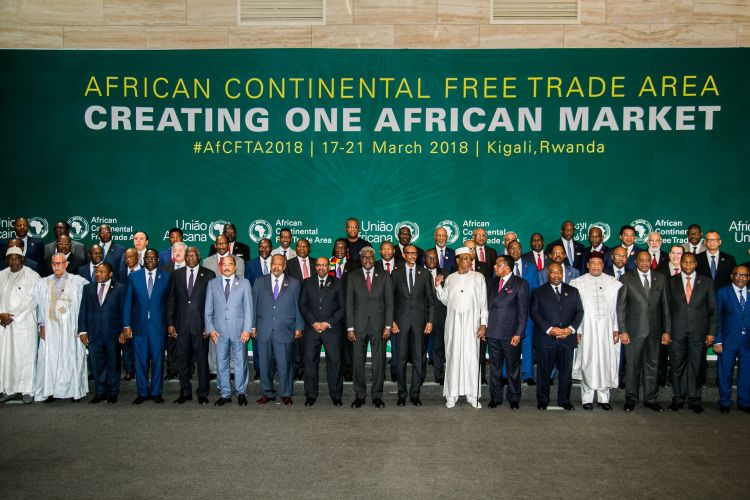
African countries opened their markets on 1st January 2021 under the Continental Free Trade Agreement ( AfCFTA) and duty-free trading of goods and services across borders. The AfCFTA was signed in Kigali in March 2018 to create a single African market for the continent. If successful, prospects of this Continental Free Trade Agreement include the creation of the largest economic zone in the world and this will boost trade and economic growth in Africa through the elimination of tariffs on intra-African goods. The market is estimated to be as large as 1.3 billion people across Africa, with a combined gross domestic product (GDP) of $ 3.4 trillion. This has the potential of lifting up to 30 million Africans out of extreme poverty, according to the World Bank.
Additionally, Africa will achieve influence over other trading blocs around the world. It is also expected to boost intra-Africa trade, promote industrialization, create jobs and improve competitiveness of African industries on the global stage.
Prospects of the AfCFTA
The AfCFTA is expected to boost trade and economic growth in Africa while strengthening integration among African countries due to the elimination of tariffs on intra-African goods. This agreement will also provide great opportunities for entrepreneurs, businesses and consumers across the continent and the chance to support sustainable development.
Accomplishing a Continental Free Trade Area will help exchange and monetary development in Africa while reinforcing incorporation among African Countries through the end of taxes on intra-African products. According to Danso (1995) a larger trading bloc will give Africa influence with other trading blocs such as the European Union (EU) and North American Free Trade Agreement (NAFTA).
In an increasingly globalized world, we might ask ourselves what importance the AfCFTA plays for African countries. The elimination of tariffs will boost economic growth of African countries while transforming their economies to achieve the Sustainable Development Goals (SDGs). Additionally, the CFTA is expected to be a greater success if non-tariff measures are addressed and informal trade is integrated into formal channels and the agreement includes trade services.
In the long-run, this trade liberalization will allow firms to access a large continental market and gain economies of scale. At consumer level, it will allow consumers to access a greater variety of products at lower prices. The lower costs of imported raw materials and intermediate inputs will increase competitiveness of downstream producers and promote the generation of regional value chains. Increased competitiveness may improve firm efficiency but market consolidation may arise when smaller firms are exposed to stiffer competition.
However, this does not mean that the AfCFTA will not pose any challenges and threats for the member states. In fact, prior continental common policies by the African Union have not always been successful past the ratification stage.
Challenges of the AfCFTA
(Kituyi, 2016) mentions that some of the main obstacles for the continent’s integration include: significant tariff and revenue losses. It is normal that nations with extensive manufacturing may encounter financial development and welfare picks up while littler economies may confront noteworthy monetary income misfortunes and dangers to neighborhood businesses. Furthermore, the uneven dispersion of advantages and expenses among part states may protract transactions in this way thwarting the AfCFTA’s usage.
Other sources like Azikiwe (2018) claim that the two largest economies and population groups on the continent, South Africa and Nigeria were the most hesitant to throw their weight behind the agreement. Reports indicate that there was a strong objection to signing the accord from both the Manufacturing Association of Nigeria and the Nigerian Labor Council which were both concerned that certain measures within AfCFTA would undermine local industries and bring about job losses due to reduction of tariffs by 90% resulting in a large influx of consumer goods which could undermine local markets. South Africa on the other hand, indicated that there needs to be more negotiations and evaluations by national interests.
In general, fears of tariff revenue losses and an uneven distribution of costs and benefits are among the main obstacles for the continent’s integration. Furthermore, the gains will not be equally distributed among member states. Countries with large productive capacities in manufacturing may experience significant economic growth and welfare gains while small economies and LDCs may face substantial fiscal revenue losses and threats to local industries.
James Freeman Clarke , once correctly remarked that “A politician thinks of the next election; a statement of the next generation. ” The AfCFTA, is primarily dependent on political goodwill and leadership of the continent. The AU Chairperson Cyril Ramaphosa, noted that getting the AfCFTA agreement has been a four decades journey which is not an impressive performance.
Experiences from other integration arrangement, such as NAFTA and the EU, indicate that, it is very difficult to win an election based on the implementation of a regional Free Trade Area. For politicians who are therefore thinking about their next elections, the AfCFTA may not be an urgent matter. It is not surprising therefore, that full implementation is tied to Agenda 2063, more than another four decades away! None of the current heads of State and Government will be still around then and in politics 40 years is eternity.
Lack of Common Currency and Currency convertibility. All African Economic Communities have a dream of a monetary Union, with a common currency, but when it comes to implementation, countries shy away for ceding their monetary policies to a regional central bank. Far back there were two existing regional currency unions in Africa, using the West African CFA franc, and the Central African CFA franc, respectively. Even then the CFA franc depended directly on the French Treasury which was not sustainable and colonial in nature.
In actual fact, CFA was a hungover of French Colonisation, CFA stood for “colonies française d’Afrique” or African French colonies. It is not surprising therefore, that it was abandoned in 2020 in the regime of Emmanuel Macron the first French president born after colonialism.
Africa FTA will have the population close to that of China and India, and about three times that of the USA and European Union. Yet it will be trading with 54 different currencies, which poses a big challenge. 54 countries will be trading through one of the world major currencies, probably the US dollar as transit point. Thus every transaction will be charged a transaction cost not to mention disadvantages that go with trading through a nonmember currency.
In August 2003, the Association of African Central Bank Governors announced that it would work for a single currency and common central bank by 2021. It is surprising that as the agreement begins operation on 1st January 2021, there is no mention about the common currency.
Currently, with additional challenges posed by COVID-19, the implementation of some of the operational aspects of the African Continental Free Trade Area have been temporarily suspended. The free trade area however, is still a very important element to support post-pandemic recovery and foster economic growth for Africa.
For comments or opinion write to us on info@africachinareview.com
 Africa -China Review Africa -China Cooperation and Transformation
Africa -China Review Africa -China Cooperation and Transformation
